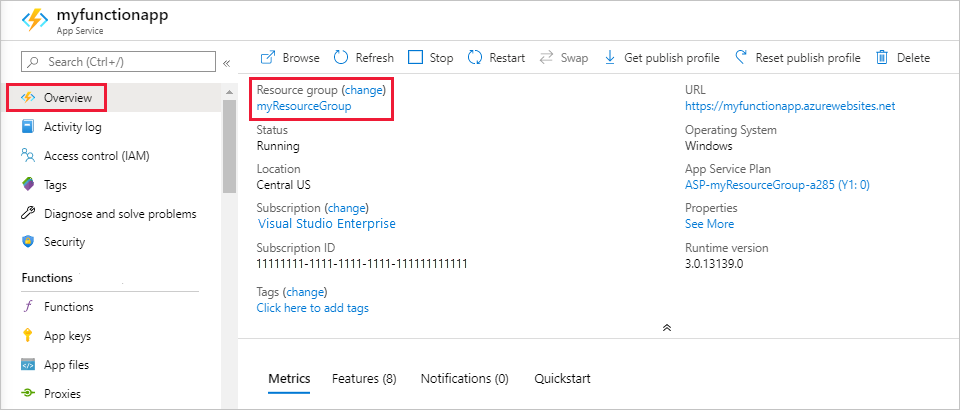Note
Access to this page requires authorization. You can try signing in or changing directories.
Access to this page requires authorization. You can try changing directories.
Azure Functions offers a scalable Premium plan that provides virtual network connectivity, no cold start, and premium hardware. To learn more, see Azure Functions Premium plan.
In this article, you learn how to use the Azure portal to create a function app in a Premium plan.
Sign in to Azure
Sign in to the Azure portal with your Azure account.
Create a function app
You must have a function app to host the execution of your functions. A function app lets you group functions as a logical unit for easier management, deployment, scaling, and sharing of resources.
From the Azure portal menu or the Home page, select Create a resource.
In the New page, select Compute > Function App.
Under Select a hosting option, select Functions Premium > Select to create your app in a Premium plan. In this serverless hosting option, you pay only for the time your functions run. To learn more about different hosting plans, see Overview of plans.
On the Basics page, use the function app settings as specified in the following table:
Setting Suggested value Description Subscription Your subscription The subscription under which this new function app is created. Resource Group myResourceGroup Name for the new resource group in which to create your function app. Function App name Globally unique name Name that identifies your new function app. Valid characters are a-z(case insensitive),0-9, and-. To guarantee a unique app name, you can optionally enable Secure unique default hostname, which is currently in preview.Do you want to deploy code or container image? Code Option to publish code files or a Docker container. Operating system Preferred OS Choose either Linux or Windows. Runtime stack Preferred language Choose a runtime that supports your favorite function programming language. Version Supported language version Choose a supported version of your function programming language. Region Preferred region Choose a region near you or near other services your functions access. Under Environment details for either Windows Plan or Linux Plan, select Create new, Name your App Service plan, and select a Pricing plan. The default pricing plan is EP1, where EP stands for elastic premium. To learn more, see the list of Premium SKUs. When running JavaScript functions on a Premium plan, you should choose an instance that has fewer vCPUs. For more information, see Choose single-core Premium plans.
Unless you want to enable Zone Redundancy, keep the default value of Disabled.
Select Next: Storage. On the Storage page, create the default host storage account required by your function app. Storage account names must be between 3 and 24 characters in length and only can contain numbers and lowercase letters. You can also use an existing account, which must meet the storage account requirements.
Unless you're enabling virtual network integration, select Next: Monitoring to skip the Networking tab. On the Monitoring page, enter the following settings:
Setting Suggested value Description Enable Application Insights Yes Enables built-in Application Insight integration for monitoring your functions code. Application Insights Default Creates an Application Insights resource of the same App name in the nearest supported region. By expanding this setting, you can change the New resource name or choose a different Location in an Azure geography to store your data. Select Review + create to accept the defaults for the remaining pages and review the app configuration selections.
On the Review + create page, review your settings, and then select Create to provision and deploy the function app.
Select the Notifications icon in the upper-right corner of the portal and watch for the Deployment succeeded message.
Select Go to resource to view your new function app. You can also select Pin to dashboard. Pinning makes it easier to return to this function app resource from your dashboard.

At this point, you can create functions in the new function app. These functions can take advantage of the benefits of the Premium plan.
Clean up resources
Other quickstarts in this collection build upon this quickstart. If you plan to work with subsequent quickstarts, tutorials, or with any of the services you've created in this quickstart, don't clean up the resources.
Resources in Azure refer to function apps, functions, storage accounts, and so forth. They're grouped into resource groups, and you can delete everything in a group by deleting the group.
You've created resources to complete these quickstarts. You might be billed for these resources, depending on your account status and service pricing. If you don't need the resources anymore, here's how to delete them:
In the Azure portal, go to the Resource group page.
To get to that page from the function app page, select the Overview tab, and then select the link under Resource group.

To get to that page from the dashboard, select Resource groups, and then select the resource group that you used for this article.
In the Resource group page, review the list of included resources, and verify that they're the ones you want to delete.
Select Delete resource group and follow the instructions.
Deletion might take a couple of minutes. When it's done, a notification appears for a few seconds. You can also select the bell icon at the top of the page to view the notification.